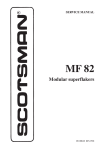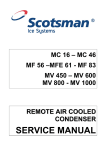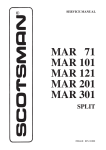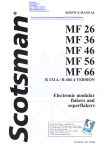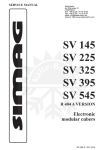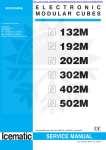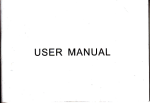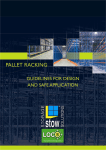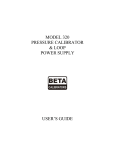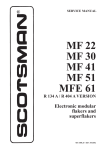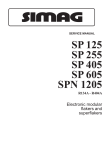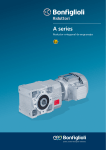Download Scotsman Flockeneisbereiter MF 86
Transcript
Page 1 Kälte-Berlin Am Pfarracker 41 12209 Berlin Page Fon: +49 30 74 10 40 22 Fax: +49 30 74 10 40 21 Mail: [email protected] Internet: www.kaelte-berlin.com 1 SERVICE MANUAL Der Link zum Scotsman Flockeneisbereiter MF 86 bei Kälte-Berlin MF 86 Modular superflakers MS 1000.28 REV. 02/2008 Page 2 Page 2 TO BE USED JUST BY THE INSTALLER Page 3 Page 3 TABLE OF CONTENTS Section I Table of contents Specifications 8 8 8 8 8 9 9 9 10 11 12 OPERATING INSTRUCTIONS Pre-start inspection Start up Section III 3 4 GENERAL INFORMATION AND INSTALLATION Introduction Description Sealed refrigerant system Storage bin or ice room Unpacking and iInspection Location and levelling Electrical connection Water supply and drain connection Remote condenser and pre-charged line Final check list Installation practice Section II page 14 14 PRINCIPLES OF OPERATION - HOW IT WORKS ICE MAKER Water Ice Refrigeration ELECTRICAL/REFRIGERATION 16 16 16 16 17 ADJUSTMENT, REMOVAL & REPLACEMENT PROCEDURES 19 Section V SERVICE DIAGNOSIS 24 Section VI WIRING DIAGRAMS Wiring Diagram MF 86 AS Wiring Diagram MF 86 ASR 26 27 28 Section VII MAINTENANCE AND CLEANING INSTRUCTIONS 29 Section IV Page 4 Page 4 SPECIFICATIONS MF 86 - AIR & WATER COOLED MODEL Important operating requirements: MINIMUM MAXIMUM • Air temperature 10°C (50°F) 40°C (100°F) • Water temperature 5°C (40°F) 35°C (100°F) • Water pressures 1 bar 5 bar • Electrical voltage variation • voltage rating specified on nameplate -10% +10% Extended periods of operation exceeding these limitations constitutes misuse under the terms of Scotsman Manufacturer's Limited Warranty, resulting in a loss of warranty coverage. We reserve the right to make product improvement at any time. Specifications and design are subject to change without notice. ice making capacity AIR COOLED MODELS 10-21 2300 32 2100 38 1900 1700 1500 ICE PRODUCED PER 24 HRS. 2500 AMBIENT TEMPERATURE Kg. 2700 °C AMBIENT TEMPERATURE ICE PRODUCED PER 24 HRS. Kg. 2700 WATER COOLED MODELS 2500 2300 2100 1900 1700 1500 38 32 27 21 15 10 WATER TEMPERATURE 5 °C 38 32 27 21 15 10 5 °C WATER TEMPERATURE NOTE. Daily ice capacity is directly related to condenser air and water inlet temperature, water temperature to make ice - and age of machine. To keep your machine performing at its maximum capacity it is necessary to perform periodic maintenance as outlined on Maintenance & Cleaning Section of this manual. Page 5 Page 5 SPECIFICATIONS (CONT'D) Dimensions: HEIGHT: HEIGHT (with legs): WIDTH: DEPTH: NET WEIGHT: 1140 mm 1290 mm 1080 mm 780 mm 400 Kg MF 86 FLAKER - COMPACT-MACHINE SPECIFICATIONS Model Cond. unit Finish MF 86 AS MF 86 WS Air Water Stainless Steel Basic electr. Air Cooled Air Cooled Water Cooled Air Cooled 230/50/3+N 400/50/3+N 230/50/3+N 400/50/3+N * At 15°C (60°F) water temperature Amps *** 13.5 *** 14 Refr. Compr. HP 5 Electric power cons. Kwh per 24 HR R 404 A 144 R 404 A Water req. lt/24 HR 2400* 26500* Nr. of wires *** 5 x 2.5 m/m2 *** 5 x 2.5 m/m2 Page 6 Page 6 SPECIFICATIONS MF 86 - AIR REMOTE COOLED MODEL Important operating requirements: MINIMUM MAXIMUM • Air temperature 10°C (50°F) 40°C (100°F) • Water temperature 5°C (40°F) 35°C (100°F) • Water pressures 1 bar 5 bar • Electrical voltage variation • voltage rating specified on nameplate -10% +10% Extended periods of operation exceeding these limitations constitutes misuse under the terms of Scotsman Manufacturer's Limited Warranty, resulting in a loss of warranty coverage. We reserve the right to make product improvement at any time. Specifications and design are subject to change without notice. ice making capacity AIR COOLED MODELS Kg. °C 2450 10 2350 2150 2050 32 1950 1850 38 1750 AMBIENT TEMPERATURE ICE PRODUCED PER 24 HRS. 2250 1650 1550 1450 38 32 27 21 15 10 5 °C WATER TEMPERATURE NOTE. Daily ice capacity is directly related to condenser air and water inlet temperature, water temperature to make ice - and age of machine. To keep your machine performing at its maximum capacity it is necessary to perform periodic maintenance as outlined on Maintenance & Cleaning Section of this manual. Page 7 Page 7 SPECIFICATIONS (CONT'D) Dimensions: HEIGHT: HEIGHT (with legs): WIDTH: DEPTH: NET WEIGHT: 1140 mm 1290 mm 1080 mm 780 mm 400 Kg MF 86 FLAKER - REMOTE MACHINE SPECIFICATIONS Model MF 86 Air Basic electr. Air Cooled Air Cooled Cond. unit 230/50/3+N 400/50/3+N Compr. HP Finish 5 Stainless Steel Amps Refr. *** 13.5 R 404 A Electric power cons. Kwh per 24 HR 144 Water req. lt/24 HR 2400* Nr. of wires *** 5 x 2.5 mm2 Page 8 Page 8 SECTION I GENERAL INFORMATION & INSTALLATION INTRODUCTION This manual provides the specifications and the step-by-step procedures for the installation, startup, operation and maintenance and cleaning of the SCOTSMAN Model MF 86 Flaker. The Model MF 86 is a quality designed, engineered, constructed and throughly tested icemaking system, providing the utmost in flexibility to fit the needs of a particular user. DESCRIPTION The Scotsman MF 86 - continuous flow ice maker - consists of one large capacity flake ice making system contained within a compact cabinet entirely in stainless steel. The flake ice produced is extruded through an ice discharge opening provided in the rear side of the unit. If the unit location requires it, the ice spout can be positioned, as well, to discharge the ice out through a second opening provided in the left side of the cabinet. All panels are removable to allow easy access to electrical and mechanical components for cleaning and maintenance. UNPACKING AND INSPECTION 1. Call your authorized SCOTSMAN Distributor or Dealer, for proper installation. 2. Visually inspect the exterior of the shipping container and skid and any severe damage noted, should be reported to the delivering carrier; and, a concealed damage claim filled in subjetct to internal inspection, with carrier representative present. 3. Remove the packing, and remove the shipping bolts and the shipping base or skid. 4. Remove screws and shipping tape, and service panels from the cabinet, and inspect for any concealed damage. Notify carrier of any concealed damage claims, as stated in step 2 above. 5. Remove all internal support packing, tape and wires in machinery compartment. 6. Remove the plastic ice chutes as well as the plastic ice spout cover. SEALED REFRIGERANT SYSTEM To provide quite efficient operation of the ice maker, the compressor is mounted on rubber grommets. The water cooled models have a tube within a tube condenser with water regulating valve for correct condensing water flow. The air cooled model has a built-in condenser with four fan motors, controlled by two pressure controls. The freezer auger is driven by a gear motor assy. The refrigerant used is R 404 A controlled by an automatic expansion valve. On request the MF 86 cal also be supplied with remote condenser and copper refrigerant lines. 7. Check that refrigerant lines do not rub or touch lines or other surfaces, and that fan blades, if any, move freely. 8. Check that the Compressor is snug on all mounting pads. 9. Use clean damp cloth or disposable paper wiper to pipe clean the exterior surfaces of the cabinets. 10. See DATAPLATE on the cabinet base and check that the location source voltage corresponds with the voltage specified on the dateplate. STORAGE BIN OR ICE ROOM Since the MF 86 is a continuous flow type ice maker and does not have its own attached storage bin, it is necessary to use an auxiliary bin or prefabricated ice room for appropriate ice storage. An insulated ice storage bin or room is always required, then - according to ice applications - this can be refrigerated or nonrefrigerated; a weight/volume ratio of 1,8 m3 per ton must be taken into consideration for correct ice storage room design which, in any case, should be dimensioned to accomodate a minimum of 16 hrs. ice production. CAUTION. Unproper voltage supplied to the ice Maker will void your parts replacement program. 11. Remove the Manufacturer’s Registration Card from the User Manual and fill in all spaces including: Model Number and Serial Number taken from the aluminium plate. Forward the completed, self addressed, registration card to the Frimont Factory. Page 9 Page 9 LOCATION AND LEVELLING WARNING. This unit must be installed in an area where it will not freeze and protected from the elements such as wind, rain, water spray or drip. Ambient temperature limitations are: 10°C (50°F) minimum and 40°C (100°F) maximum, while water temperature limitation are: 5°C (40°F) minimum and 35°C (90°F) maximum. Ambient and water temperature exceeding these limitations may result in machine malfunction and the loss of warranty coverage. Make sure that the structure on which the ice maker will be located be on a solid footing and supports at least 1000 Kgs. This ice maker is designed for free standing application only. Do not built it in. Make sure that location site is well ventilated to ensure correct operation of air-cooled models that have the condenser directly behind the front panel. Also allow 20 cm clearence in back and both side of the ice maker to be able to easily perform service inspections and operations. 1. Erection - For elevation of machine to its stand or location, fork lifttrucks should be used. 2. Position the MF 86 in the selected permanent location and level the cabinet on both the left-to right anf front-to-rear direction. 3. Ice chute to convey the ice from the outlet of the machine to the ice storage area is supplied with the machine. 4. Thermostat capillary tube must be positioned so that its end extends out the ice chute opening or the ice deflector and get easily in contact with the cone formed by the ice deposited in the storage room, before - anyway - that ice builds-up in the chute. Thermostat capillary tube is coiled behind the control box, it must be routed to follow the ice chute or ice deflector and protrude for a certain extension beyond the ice discharge opening in the storage room. Use caution when routing this capillary to prevent kink or to bent it excessively. Coil excess capillary inside ice maker cabinet. Tape coil to prevent vibration againt another part. ELECTRICAL CONNECTION See machine electrical specifications in Unit Nameplate and at page 3 of this Service Manual to determine wire size to be used for electrical supply. This unit must be grounded according to all Electrical Codes and local ordinances. Provide a fuse disconnect box within sight and easyreach of the ice maker. Use timed fuses on all terminals. The maximum allowable voltage variations should not exceed ten percent of the nameplate rating, even under starting conditions. Low voltages can cause erratic operation and may be responsible for serious damages to the overload switch and motor winding. WARNING. The compressor is equipped with a crankcase heater which has to to energized even when the ice maker is switched-off. So, make sure to connect the unit with the compressor crankcase heater constantly energized. After long inoperative periods remember to give current to the heater 4 hours before the ice maker start-up. WATER SUPPLY AND DRAIN CONNECTIONS A. AIR-COOLED MODELS: The recommended water supply line is a 3/4 inch O.D. fitting. Connect to cold water supply line with standard plumbing fittings, with a shutoff valve installed in an accessible place between the water supply and the Cabinet. A wire mesh strainer is provided inside the fitting. The strainer protects against large particles of rust, scale, etc., which may be loosened in the water supply pipe at the time of installation. In some cases, a plumbing permit and services of a licensed plumber will be required. CAUTION - This ice maker is equipped with a low water pressure safety device which, in the event of low water pressure, will automatically stop the ice maker to prevent damage. The ice maker will automatically restart with increased water pressure. This ice maker will not operate properly when water supply temperatures are below 5°C (40°F) and above 35°C (90°F). B. WATER-COOLED MODELS: On WaterCooled models a separate connection, to the Condenser is required. A 3/4 inch O.D. fitting is provided for a separate water inlet line to be connected and a separate drain line to be connected. NOTE. - The WARNING, in the text above for the Air-Cooled models equally applies for the Water-Cooled models. In both type installations, water supply must be installed to conform with local plumbing codes. In some cases, a plumbing permit and services of a licensed plumber will be required. C. WATER DRAIN The recommended drain tube is a plastic or flexible tube with 18 mm (3/4") I.D. which runs to an open trapped and vented drain. D. WATER DRAIN - WATER COOLED MODELS Connected the 3/4" male fitting of the condenser water drain, utilizing a second flexible hose, to the open trapped and vented drain. Page 10 Page 10 WEATHER PROOF AIR COOLED REMOTE CONDENSER Installation of the remote air cooled condenser and pre-charged refrigerant lines The remote condenser version is similar to the air cooled standard version with the only difference of the remote condenser and of the Fan Speed Control used to supply power to the three fan motors. A. Location considerations: Select the best available place protected from dirt/dust. The weather proof remote air cooled condenser can be installed indoor as well as outdoor and can operate under the most different conditions (rain, wing, snow, etc.). Use the following formula for planning the location of the condenser and ice machine. Technical specifications 1. Remote air cooled condenser fit on proper brackets for horizontal and vertical installation. Cooling capacity with T 15K is 17700 Kcal/hr. 2. Fan motors 220-240/50-60/1 - 135 Watts 0,6 Amps with IP44 protection (against liquids and solids) and flow rate of 2150 m3/hr. 3. An Electronic Fan Speed Control set to 16 bar. 4. Pre-charged refrigerant lines of 10 meters length equipped with AEROQUIP quick connections. 5. 6. Location Limits - Condenser location must not exceed ANY of the following limits Maximum vertical drop dd of 1 meter between the icemaker and the remote condenser. Maximum vertical rise rd of 3 meters. Physical line set maximum length between icemaker and remote condenser is 10 meters. Limit to max. one rise and one drop. Limit the calculated distance (CD) as per the Calculation formula to 18 meters. Hi pressure safety control (manual reset type) set to 34 bar. A = Drop = dd x 6.6 B = Rise = rd x 1.7 C = Horizontal run = hd x 1 Hi pressure control warning light. CD = A + B + C hd Remote Condenser located ABOVE Ice Machine rd dd Remote Condenser located BELOW Ice Machine Condenser Distance & Location Schematic Page 11 Page 11 B. Unpacking and inspection: Visually inspect the exterior of the shipping container; any severe damage should be reported to the delivery carrier. Uncrate the remote condenser and pre-charged refrigerant lines and inspect for any concealed damage. Notify carrier of any cancealed damage. Check that the pre-charged refrigerant linea are intact, not kinked. C. Remote condenser installation Install and attach the remote condenser to the floor or to the wall of the building using methods and practices conform to the local building requirements. Remove the control box cover from the remote condenser and connect the electrical power line coming from the unit following the wires colors. NOTE. Cable connecting the unit to the remote condenser is at 230 Volts so it is imperative to have the cable properly protected inside a plastic or metal tube according to the local electrical code/standard. D. Pre-charged refrigerant lines The set of pre-cherged refrigerant lines consists of the 16 mm O.D. gas line and 12 mm O.D. liquid line with AEROQUIP quick connections too. Whenever then length of the pre-charged refrigerant lines are longer then the distance between the ice maker and the remote condenser keep the excess portion indoor shaped as a vertical spiral so to avoid refrigerant trapping. CAUTION. Each coupling on the precharged refrigerant lines is self-sealed and should be tightened 1/4 turn more then snug tight. ALWAYS USE TWO WRANCHES WHEN TIGHTENING THESE FITTINGS, ONE AS BACKUP WRENCH TO PREVENT TWISTING OF TUBING AND POSSIBLE KINKING OR LINE RUPTURE. Connect the gas line coupling to the remote condenser refrigerant fitting (labelled GAS) and to the refrigerant fitting on the rear side of the ice machine. Connect the liquid line coupling to the remote condenser refrigerant fitting (labelled LIQUID) and to the refrigerant fitting on the rear side of the ice machine. ATTENTION. The inlet of the remote air cooled condenser (gas) must be always located above the outlet (liquid) for both horizontal and vertical installation. Operating instructions The remote air cooled condenser version is operating in the same way as the standard machine. The only difference is the operation of the fan motor. In place of the fan pressure control operation in ON-OFF mode, on remote air cooled condenser version it's installed an electronic fan speed control. The fan speed control supplies a variable power to the fan motors so to modulate their speed and keep to a constant value the discharge pressure. Correct adjustment of the fan speed control is 16 bar. The hi pressure control is used only as a safety device to switch OFF the operation of the machine in case of fan motor failure. FINAL CHECK LIST 1. Is the Cabinet level? (IMPORTANT) 2. Have all electrical and piping connections been made? 3. Is there an electrical service disconnect within sight of the installed machine? Has the voltage been tested and checked against the nameplate rating? 4. Is the water supply line shutoff valve installed near the machine. 5. Have all the wires been checked for looseness and thightness. 6. Have the Compressor hold down nuts been checked, to be sure the Compressor is snug on the mounting pads. 7. Has the owner/user been instructed on how to operate the Icemaker. 8. Has the Manufacturer’s registration Card been properly filled out? Check for correct Model and serial numbers from Serial nameplate, then mail the completed card to the FRIMONT factory. 9. Check all refrigerant linea and conduit lines, to guard against vibration or rubbing and possible failure. 10. Is there at last 20 cm. clearance behind and around Cabinet for proper air circulation? 11. Is the Icemaker installed indoor in a location where ambient temperatures are a Minimum of 10°C (50-degrees F.) all year around? 12. Has water supply pressure been checked to insure a minimum of 1 atm (14 PSI). 13. Is the remote condenser installed per local building codes, and in a place where it has adequate ventilation and minimal solar heat gain. 14. Verify that unit lighted switch is in the OFF position. 15. Switch the main disconnect switch on power line in the ON position to energize the compressor crankcase heater well in advance the start-up. 16. Verify that dial of delay timer, in control box, is set on 5 minutes. 17. Has the owner been given name and telephone number of the authorized SCOTSMAN Service Agency. Page 12 Page 12 INSTALLATION PRACTICE Page 13 Page 13 INSTALLATION PRACTICE 1 ➀ 2 ➁ 3 ➂ 4 ➃ 5 ➄ 6 ➅ POWER LINE HAND DISCONNECT SWITCH CONTROL TIMER (OPTIONAL) WATER SUPPLY LINE HAND SHUT - OFF VALVE WATER FILTER (NOT SUPPLIED) 7 ➀ 8 ➁ 9 ➂ WATER INLET LINE W / SEPARATE SHUT - OFF VALVES WATER DRAIN LINE OPEN VENTED DRAIN Page 14 Page 14 SECTION II OPERATING INSTRUCTIONS PRE-START INSPECTION 1. Make sure that the electrical power has been on for at least 4 hours and that compressor crankcase is warm. 2. From unit left side check to see, through appropriate sight glass, the oil level in gear box and also the oil level in compressor crankcase. 3. Verify that drive motor current limiter GAVAZZI DIB71, located in control box on right side of contactor, has the following setting. 400V 230V HYS LEVEL 6 60% - 1,2 Amps *** *** DELAY 0,3 - 1,8 sec *** 2. Press unit lighted switch to ON. Unit will start operating. Verify immediately if auger drive motor turns the auger (coupling) in counterclockwise direction. NOTE. The MF 86 is equipped with a 3 Phase Monitoring Relay. In case the three phase are connected in wrong way, the machine doesn't start with the simultaneous glowing of the 3 Phase Sequence Protector Warning light. Just reverse two of the three phases on the main plug so to have the correct sequence and by so, the start up of the machine. 3. 15 minutes, after the start up of the drive motor (yellow led of the Time Delay Relay KT1 blinking), the compressor starts up as well. 4. After two or three minutes of unit operation observe that flaked ice begins to drop out in the ice spout. START-UP The following procedure can only be started after pre-start inspection has been properly completed. 1. Open the water supply line shutoff valve. Observe that water enters the water reservoir, fills the tube from the reservoir to the evaporator and then shut-off. Check for leaks. 5. Let the system operate for about 30 minutes. Check for any excess noises beyond normal compressor noise: a) Fan noises when Air-Cooled: blades touch other surfaces; blades bent; out of balance. b) Vibrating type from touching lines. c) Chattering: lack of water in Freezer. d) Compressor loose at one or more holddown bolts. 6. If desired, the low side pressure can be checked, it should be 1.7 atm (25 PSI). Check to see through liquid sight glass for correct refrigerant flow and charge. 7. Hold a handful of ice around the ice storage bin thermostatic control bulb to test shut-off. Less than one minute is about normal for bulb shut-off function to cause the ice maker to stop (Compressor first and drive motor after 15 minutes delay - yellow led of KT2 blinking). Remember that unit will resume operation after 15 minutes that bin thermostat has closed its contacts. 8. There are no adjustments to make, so replace the panels. Page 15 9. Throughly explain the owner/user the significant specifications of the ice maker, the start-up, operation and attention to pay going through the procedures in the operating Page 15 instructions. Answer all questions about the ice maker, by the owner, and inform the owner of the name and telephone number of the authorized SCOTSMAN Service Agency serving him. Page 16 Page 16 SECTION III PRINCIPLES OF OPERATION - How it Works ICEMAKER: Water The water supply flows from the building source through the inline water strainer, enters at the Cabinet fitting and on to the Water Reservoir. The water Reservoir functions to maintain a constant water level inside the Freezer Assembly. Water from the Water Reservoir enters at the bottom of the freezer Assembly and is changed into ice by low temperatures inside the freezer. Ice A stainless steel Auger within the Freezer is powered by a separate drive motor through a speed reducer and the rotating Auger carriers the ice upward to the Ice Breaker assy where excess water is pressed out of the ice, as it is extruded or flaked out through the Ice breaker. The flake ice into spout in diverted out through the ice discharge opening. Moving the manual ON-OFF toggle switch, to the ON position starts after 15 minutes the automatic and continuous icemaking process. When the Ice touches the Thermostatic Control Bulb, the sensing bulb shuts off the compressor first and 15 minutes later the drive motor. Refrigeration Beginning at the compressor, the refrigerant R 404 A is compressed into a high temperature gas. The discharge line directs this gas to the condenser. At the condenser (air or water cooled), the gas is cooled by either air or water and it then condenses into liquid. This high pressure liquid then goes through the liquid line to the expansion valve. The expansion valve meters liquid refrigerant into the evaporator. At the evaporator, the refrigerant enters an area of relatively low pressure where it can easily "boil-off" or evaporate. Page 17 Page 17 As it evaporates, it absorbs heat from the evaporator and whatever is in contact with it (such as the water inside it). After the evaporator, the refrigerant, now a low pressure vapor, goes through the heat exchanger and suction line back to compressor, where the cycle is repeated. ELECTRICAL/REFRIGERATION The MF 86 Flakers are designed to operate at 400 Volts. 50 Hertz, threephase plus neutral. Special voltage requirements are available on special order. Therefore, always CHECK NAMEPLATE for electrical information BEFORE proceeding with electrical wiring connections to the Icemaker. Cold ambient temperatures and interruptions in water supply are conditions that can cause excessively hard ice and overloads within the Freezer Assembly, which is directly trasmmitted to the Drivemotor; and in turn, will cause the intervention of Drive Motor Current limiter. Spout Switch is mounted on the top of the Ice Spout and is actuated by the movement of the spring retained pressure plate. The spout switch acts as a back-up safety switch, should the termostatic Control Bulb fail and cause ice to jam-up in the ice spout. The switch will shutoff the ice maker when actuated. The Spout Switch can be manually tested by pressing upward the pressure plate. There are other five safety controls in the machine and are: The low Pressure Control an automatic reset, adjustable control, set to electrically open at 0.3 bar (4 PSI) to stop the entire ice maker, prevents operation at vacuum refrigerant pressures and restart when rises up to 1 bar (14 PSI). Drive Motor Current Relay - Gavazzi DIB71 It senses the intensity at the drive motor, should this exceed its Amps setting point as per here below chart, tripping OFF the entire machine. 400V 230V HYS LEVEL 6 60% - 1,2 Amps *** *** DELAY 0,3 - 1,8 sec *** To restart the unit it's necessary to push the Reset Button. Setting of the 6 Dip Switches, located behind the small service panel, MUST be in ON position for all of them. On water cooled models correct head pressure is 17 atm (240 PSI). Adjustments can be made on the Water regulation Valve. Air cooled models are equipped with two upper and lower fan motors. Both pair of motors are controlled by individual high pressure controls that are connected to the systems high side. The left fan control with not operate until high side pressure reach 16.5 atm (230 PSI). The right fan control will not operate until pressure reach 17 atm (240 PSI). This way, in colder ambients only the upper fan motors operate. In higher ambients the lower fans will cycle on/off. In extremely high ambients all four fan motors operate. Suction pressure should be 1.7) atm (25 PSI) with proper refrigerant charge. When charging the system with refrigerant - on water cooled models - set the compressor head pressure at 17 atm (240 PSI) and charge with refrigerant so that the frost line extends out of the compressor at least eight inches after 15 minutes operation for best capacity and performance. MF 86 REFRIGERANT CHARGE The low-water pressure Switch functions to discontinue the ice making process whenever incoming water pressure is reduced to below 0.3 bar (4 PSI). The switch will automatically restart the icemaking process when the water pressure is increased to 1 bar (14 PSI). MODEL Air cooled Water cooled Remote air cooled The manual Reset High head Pressure Control is factory set to stop the entire icemaker should the head pressure reach 34 bar (490 PSI). Cut IN is set up at 25 bar. CONTROL CONSOLE Compressor delay timer Delays the start up of the compressor by 15' at every start up of the ice maker. Gear motor delay timer Delays gear motor STOP by 15' at every trip OFF of the ice maker. 3 - phases monitoring relay On the power in of the machine check and assure correct Wiring - rotation of the gear motor. R 404A R 404A R 404A 4300 gr. 2200 gr. 4700 gr. Located on the front panel is a virtual control console that monitors unit performance automatically. Any interruption or significant reduction in water or electrical supplies causes an instant stop to the operation of the modular flaker. At the same time a warning light is activated on the control console telling the user of the ice makers stoppage and also the reason why. If the stoppage is caused by its refrigerant pressures or overloading in the drive train mechanism a warning light glows, the cause of the stoppage should be diagnosed and corrected before reoperating the ice makers corrected before reoperating the ice makers stoppage and also the reason why. Page 18 Page 18 The warning light signals low or interrupted water supply. This light and its internal control are on an automatic reset device whereby the icemaker will automatically start up and the red light goes off when water pressure reaches 1 bar (14 PSI) or more. Two other lights signal respectively Compressor Motor Overload and Bin Thermostat cut-out situation. Both these controls are automatic. Besides the compressor that has important function to provide refrigerant to the evaporator to form ice, in the MF 86 flaker there are the following components that worth to be mentioned: TOO HI DISCH. PRESS. TOO LOW SUCT. PRESS. TOO LOW WATER PRESS. The gear reducer is securely bolted on the chassis base and supports the freezing cylinder as well. On its input shaft there is fitted the driving pulley. A separate output shaft with double keys is fitted in the gear box bore and connected to the auger shaft via aluminium casting coupling. The Bin Thermostat Ranco K 22 - L 1075 - must have its sensing capillary extended into ice room in a way that it could be contacted by the ice when storage ice room becomes filled. It terminates ice production when its capillary gets in contact with ice. It is wired in series with all other controls. It is factory set to cut-out at 1,5°C and cut-in at 4°C. The Condenser Water Cooled is tube within a tube with end plate manifold to permit cleaning of water tube. Its heat rejection is of 12.000 Kcal/hr. The Condenser Water Valve PENN 1/2" Bellow type - Regulated water flow through the condenser to maintain constant head pressure at 17 atm (240 PSI). The Drier Filter is Castel 164S of cm3 250 capacity to dehydratate moisture in the system. SPOUT SWITCH BIN THERMOSTAT The Expansion Valve is FLICA mod. AMVX 3 Press 3 bar - Office 4.5 mm for R 404 A - meters the refrigerant to the evaporator serpentine at 1.7 bar (25 PSI). 3 PHASE MONITORING RELAY The Compressor Contactor Telemecanique LC1D25 - with 4 N.O. and 1 N.C. contacts at 400V 25A with 230V coil. DRIVE MTR CURRENT RELAY COMPR. PROTECTOR The Drive Motor Bonfiglioli mod. BN80A4 0.55 Kw Volts 230/400 Ph 3 Hz 50 Amps 2.65-1.53 RPM 1410 thermally protected. Provides power through speed reducer to turn auger. The Condenser Fan Motor on Air Cooled Mod. only - 4 X unit - Elco mod. 3RGH 70/30/1 Watts 70 - amps 0,7 - Volts 220 - Ph 1 - Hz. 50 RPM 1300 - Thermally protected Capacitor µf 3,15 - Volts 450 - Fan 300 m/mm3/h 1750. The Gear Reducer Bonfiglioli mod. VF/W49/110 Ratio 1/400. High and lo speed gear box are oil lubricated. Oil Must be changed at LOW SPEED SECTION every 25.000 hours. Use lt. 1.8 of Syntethic Oil only: SHELL TIVELA OIL SC 320 Drive Motor Contactor Telemecanique LC1K09 - with 4 N.O. contacts at 400V 9A with 230V 50-60 Hz coil. The Evaporator: a vertical stainless steel tube, refrigerated, and water filled. In it there is a stainless steel auger and a water seal. The Auger: a stainless steel triple spiral auger, it pushes the ice ribbon up to the top of the evaporator. The Water Seal: a two part "face" seal, the top half rotating with the auger, the bottom half stationary, the sealing action being where the two seal "faces" meet. The Breaker: where the ice is compressed and much of the extra water is squeezed out of it before it reaches the ice spout. The Thrust Bearing (Top bearing): as the ice is, pushed up the evaporator, the auger is thrust down, and pressure from the auger thrust is taken up by this bearing. Page 19 Page 19 SECTION IV ADJUSTMENT AND REMOVAL AND REPLACEMENT PROCEDURES The procedures provided in this Section are arranged in alphabetical order, to make specific Adjustment and Removal and replacement information easy to locate. Read the instructions throughly before performing any Adjustment or Removal and Replacement Procedures. 1. ADJUSTMENT OF THE BIN THERMOSTAT CONTROL The control for the Bin Thermostat is the Temperature Control, located in the Control Box Assembly. WARNING - The adjusting screws on the Temperature Control device have very sensitive response to adjustment. Over-adjusting or erratic guessing, can foul the instrument and cause ultimate delay and part replacement, WHICH COULD HAVE BEEN PREVENTED. RAISE or LOWER the Water Level by raising or lowering the Water Reservoir and its Mounting Brackets. A. To RAISE the Water Level: loosen and remove the two screws which attach the Mounting Bracket of the Water Reservoir to the frame and raise the Water Reservoir Assembly of the desired amount; then thread the screws in the corresponding holes and tighten. B. To LOWER the water Level: loosen and remove the two screws which attach the Mounting Bracket of the Water Reservoir to the frame and lower the Water Reservoir Assembly of the desired amount; then thread the screws in the corresponding holes and tighten. WARNING. - Be sure the electrical power supply and the water supply are OFF, before starting any of the following REMOVAL AND REPLACEMENT procedures, as a precaution to prevent possible personal injury or damage to equipment. Factory settings is +1,5°C cut-out and +4°C cutin. 2. ADJUSTMENT OF THE WATER REGULATOR ASSEMBLY (WATER COOLED ONLY) The correct head pressure on MF 86 Flakers is 17 atm (240 PSI). Adjustments can be performed on the Water Regulator Assembly to increase or decrease the head pressure. To Adjust the Water Regulator Assembly: A. To INCREASE the Head Pressure: Rotate the adjusting Screw, on the Water Regulator Assembly IN or CLOCKWISE. B. To DECREASE the Head Pressure: Rotate the adjusting Screw, on the Water Regulator Assembly OUT or COUNTERCLOCKWISE. 3. ADJUSTMENT OF THE WATER LEVEL INTO THE FREEZER CHAMBER The correct Water Level in the Freezer Chamber is about 2 cm (3/4 inch) below the ice discharge opening. Low Water Level causes excessive strain inside the Freezer Assembly due to a faster freezing rate. When the Water Level is above or below the correct level adjustment can be performed to 4. ADJUSTMENT OF THE AUTOMATIC EXPANSION VALVE This valve may be manually regulated by means of the adjusting stem. Turning the adjustment to the left counterclockwise, will increase the rate of refrigerant flow. Turning the adjustment to the right (clockwise), the refrigerant flow to the evaporator is reduced. Use hex head wrench for manual adjusting operations. 5. ADJUSTMENT OF FAN MOTOR PRESSURE CONTROL CAUTION - To prevent electrical schock or damage to equipment, when the cover is removed ensure that power supply is switched off. Two reverse acting, automatic reset, high pressure controls fitted inside the control box are electrically connected to the condenser fan motors and by a capillary tube to the liquid line. Their function is to maintain the head pressure at 16.5 and 17 bar (240 -245 PSI) with a fixed differential range of 1 bar (14 PSI). Page 20 Page 20 To adjust the condensing pressure turn the grooved adjusting stem by the special adjusting key P/n 00102300 clockwise to dicrease or Counter-clockwise to increase the setting point. B. To replace the Condenser, reverse the removal procedure. 7. NOTE. A. These are general steps to be followed at first, when removing any part of any refrigeration system, which are in summary. a) Store the refrigerant charge in compressor crankcase. b) Remove all refrigerant from part to be opened. c) Balance pressures in parts just evacuated. d) Isolate parts to be opened from the rest of the system. e) Clean and dry joints to be broken. f) All refrigerant openings should be immediately plugged as soon as they are opened. g) Upon reassembling, it is necessary to remove all the air moisture from the lines and whatever part that has been open to. 6. The liquid refrigerant must be removed from the condenser and the pressure in the condenser must be adjusted to atmospheric pressure. To remove the condenser: 1. Remove screws and the front panel and the left side and right side panels. 2. Bleed off or blow the refrigerant charge through the service valve after closing compressor service valves; isolate the condenser. 3. Unsolder the refrigerant inlet and outlet lines from the condenser. 4. Close off water circuit, disconnect the water inlet and outlet lines from the condenser and drain as much water as possible from the condenser. 5. Remove bolts, lockwashers and washers which secure the condenser to the chassis mounting base. 6. NOTE. Always install a replacement Drier, anytime the sealed Refrigeration System is opened. Do not replace the Drier until all other repairs or replacements have been completed. A. To remove the Compressor Assembly: 1) Remote screw and Right, Front, Rear and Left Panels. 2) Remove two screw and the Cover from the Compressor Junction Box. 3) Disconnect the electrical leads at the Compressor Junction Box that originate in the Control Box. 4) Close both suction and discharge Service Valves. Bleed off or blow the refrigerant in compressor through the Service Valves. WARNING - Removal of compressor because of its weight could present a problem. Carts, small Hydraulic Hoists, etc. must be made available to move the compressor. REMOVAL AND REPLACEMENT OF THE WATER COOLED CONDENSER NOTE. Always install a replacement Drier, anytime the Sealed Refrigeration System is opened. Do not replace the Drier until all other repairs or replacements have been completed. Remove the condenser from the cabinet. NOTE. Thoroughly evacuate the System to remove moisture and non - condensables. REMOVAL AND REPLACEMENT OF THE COMPRESSOR ASSEMBLY 5) Unbolt the suction service and discharge service valves from the compressor (DO NOT REMOVE THE LINES FROM THE VALVES). 6) Immediately plug all the openings through which refrigerant flows using dry rubber, cork stoppers or tape. 7) Disconnect the compressor base bolts that hold the compressor to the base. 8) Plug compressor refrigerant opening to prevent oil from spilling out during compressor removal, if this one is tilted. 9) Slide the compressor out from unit chassis from the rear side. B) To replace the compressor assy reverse the removal procedures. 8. REMOVAL AND REPLACEMENT OF THE DRIER A. To remove the Drier: 1) Remove screws and all service panels. 2) Remove screws and Drier brace attaching the drier to the Chassis. 3) Bleed off or blow the refrigerant charge through the service valve. 4) Unloose the refrigeration lines flare nuts at each end of Drier, remove the Drier and separate drier from the drier brace. Page 21 A. To replace the Drier: CAUTION 1. If the factory seal is broken on the replacement drier, exposition of it to the athmosphere, more than a few minutes, the Drier will absorb moisture from the atmosphere and loose substantial ability for moisture removal. 2. Be sure the replacement Drier is installed with the arrow positioned in the direction of the refrigerant flow. 1) Remove the factory seals from the replacement drier and install the drier in the refrigerant lines with the arrow positioned in the direction of the refrigerant flow. Page 21 4. Disconnect the water inlet line at the rear of the Water Regulator. 5. Disconnect the Condenser water inlet tube at the front of the Water Regulator. 6. Remove two screws, lockwashers and washers which attach the Water Regulator Assembly bracket to the Chassis base and remove the Water Regulator Assembly and bracket. NOTE. - Thoroughly evacuate the System to remove moisture and non - condensables. B. To replace the Water Regulator Assembly reverse the removal procedure. 2) Install the drier brace on the drier. 3) Tighten the flare nuts to both drier fittings to connect the refrigerant lines. 4) Purge the system and check for leaks. 5)Throughly evacuate the system to remove moisture and non-condensables. 6) Charge the system with refrigerant, by weight. SEE NAMEPLATE. 7) Re-mount all Service Panels. 11. REMOVAL AND REPLACEMENT OF THE AUGER, WATER SEAL, BEARINGS AND COUPLING A. To Remove the Auger, Water Seal, Bearings, and Coupling: 1. Remove screws and the Front Panel and the Top Panel. Shut close water supply. Drain the water reservoir and freezer assy using the drain tube attached to the freezer water inlet. 2. Remove the screws that secure the spout to the stop of the Freezer Assembly. 9. REMOVAL OF EXPANSION VALVE A. To remove the expansion valve: 1. Remove screws and service panels. 2. Close service valves on liquid line. 3. Run the compressor for a moment until the evaporator coil has no liquid refrigerant in it. 4. With the compressor idling, equilize the pressure by cracking the liquid line service valve. 5. Turn the suction service valve stem all the way in. 6. Dry and clean the expansion valve accurately. 7. Remove the liquid line and unbolt the valve. 8. Seal refrigerant openings immediately. B. To replace the expansion valve reverse the removal procedures. 10. REMOVAL AND REPLACEMENT OF THE WATER REGULATOR ASSEMBLY WATER - COOLED MODELS A. To remove the Water Regulator Assembly: 1. Remove screws and the Service Panels. 2. Bleed off or blow the refrigerant charge through the Schrader valve. 3. Unsolder the Capillary line from the Water Regulator Assembly, where connected at the process header. 3. Disconnect wires from micro box spout switch. 4. Remove micro-box and the spout assy. 5. Remove center plastic cap that protects top bearing. 6. Unloose and remove center bolt that secures the ice breaker to the auger. 7. Unloose and remove 8 screws that hold the ice breaker to freezer barrel. (Two longer screws are used with freezer side bracket). 8. Insert two of these screws into two threaded-blind holes, which must have no bottom on barrel and by evenly drawing them down, ice breaker is lifted up. 9. Grasp the ice breaker and lift it up entirely. Worm shaft witt remain into the freezer worm tube. 10. With a rowhide mallet or a piece of wood placed on the bottom end of the top bearing, tap the bottom of the bearing to break it loose to be pulled out from ice breaker. 11. Clean away old grease and replace the "O" rings in the ice breaker. 12. Insert in auger hub threaded hole an eyebolt of 16 m/m in order to offer sufficient and positive hook for pulling-out the auger. 13. Lift and pull-out the auger with the help, eventually of a small hydraulic Hoist. Page 22 NOTE: 1. Any time the Auger is removed for replacement, or, for the inspection and replacement of the Bearing or Coupling, use extra care in handling the Water Seal parts, so no dirt or foreign matter are deposited on the surfaces of the Seal. 2. If there is any doubt about the effectiveness of the Water Seal or O-Ring, REPLACE THEM. A dirty, worn or faulty Water Seal or O-Ring will cause a leak and ultimately require a second, time consuming, removal and replacement procedure to be performed, that COULD HAVE BEEN PREVENTED. 3. Lower bearing or water seal should be removed by pulling-out the bearing retainer from the bottom of freezer barrel. You can heat the bearing retainer with a soft flame. The bearing will drop out by itself. 14. Remove screws and lockwashers which attach the Freezer Assembly to the Adaptor on the Gear box. 15. Raise the Freezer Assembly off of the Adaptor, to gain access to the Bearing Retainer; then, temporarily secure the Freezer Assembly out of the way to allow room to work. 16. Unloose and remove the four screws that secure the bottom flange to the worm tube. Page 22 NOTE: 1. When installing the Bearing, in the bearing retainer carefully tap a piece of wood positioned across the bearing, to evenly seat the Bearing in the retainer. 2. After assembling the ice breaker on the upper end of the Auger and BEFORE installing the Cap apply an ample coating of vary bond grease type Never Seez food grade H1 - certified -20°C +150°C Grease, P/ N 263612 00, to the upper part of the Bearing, the Cap Screw and Washer. Then, install the Cap in place. 12. REMOVAL AND REPLACEMENT OF THE FREEZER ASSEMBLY NOTE: 1. The Cabinet may have to be removed from is permanents location, especially if located in a corner, in order to have access to the left side and rear of the Chassis. 2. In addition to shutting OFF electrical power and inlet water to the icemaker, be sure to disconnect the inlet water line BEFORE moving the icemaker from the permanent location. 3. Always install a replacement Drier, anytime the sealed refrigeration system is opened. Do not replace the Drier until all other repair or replacement has been completed. A. To Remove the Freezer Assembly: 1. Remove screws and left and right side rear panels. 17. Push out to remove the seal ring. 2. Refer to procedure IV-12 and remove the Spout Assembly, Ice Breaker and Auger. 18. Remove the clip ring and the bearing from the bearing retainer. 3. Remove Corbin clamp and Tygon tube from the Freezer Assembly that connects to the Water Reservoir Assembly. 19. Inspect the lower half of the Water Seal. If reusable, use care to protect it from dirt, etc. prior to replacement procedure. 4. Perform operation at steps 2-3-4-5 at procedure IV-10. 20. Inspect the lower Bearing and, if the Bearing is dry replace it with a new one. 5. Disconnect suction line joint from the freezer. 6. Unsolder the refrigerant inlet line at the freezer. 21. Inspect the O ring of lower bearing retainer - eventually replace it with a new one. 7. Remove screws that secure bracket of freezer to the left side of chassis. 22. Reach through the Adaptor and remove the Coupling for inspection. 8. Remove screws, lock washers and washers which attach the bottom of the Freezer Assembly to the Adaptor on the Gear box. 23. Check the Coupling for cracks, chipping and excessive wear. 9. Lift the Freezer Assembly up and off of the Adaptor of Gear box. NOTE: Throughly evacuate the System to remove moisture and non - condensables. B. To replace, the Auger, Water Seal, Bearings, and Coupling, reverse the removal procedure. B. To replace the Freezer Assembly, reverse the removal procedure. Page 23 13. REMOVAL AND REPLACEMENT OF THE WATER RESERVOIR ASSEMBLY A. To remove the Water Reservoir Assembly: 1. Remove screws and the left Panel and the Top Panel. Close the Water Supply. Drain water reservoir and freezer assy. Using the drain tube attached to the freezer water inlet. NOTE: Be prepared with container or rags, to catch water left in lines, when lines are disconnected in next steps, to prevent draining water on parts, components, electrical lines, etc. 2. Disconnect the water inlet tube from the Water Reservoir Assembly. 3. Remove two corbin clamps and two tubes from the bottom of the water reservoir assy and damp all water in them by bending them down in a pail. 4. Unscrew and remove the screws that secure the water reservoir bracket. 5. Remove the Water Reservoir Assembly, from the mounting bracket. B. To replace the Water Reservoir Assembly, reverse the removal procedure. NOTE: Check that the installed replacement Water Reservoir Assembly float moves freely. Page 23 2. Disconnect wire leads to motor. 3. Remove four hex head bolts, lockwashers and washer which attach the motor to the gear reducer. 4. Remove the drive motor out of the gear reducer. B. To replace the drive Motor reverse the removal procedure. 15. REMOVAL AND REPLACEMENT OF GEAR BOX A. Remove screws and all service panels. 1. Remove four nuts and washers which hold the gear box adaptor to the evaporator assembly. 2. Unloose and remove screws securing upper evaporator bracket to left side chassis. 3. With a small hydraulic Hoist raise the evaporator assembly to facilitate removal of entire gear box. 4. Unloose and remove four nuts holding the gear box to unit base. The gear box is now loose and can be removed. Do not tilt to avoid oil spillage. NOTE: Gear box is supplied with the drive motor already in place. 14 REMOVAL AND REPLACEMENT OF THE DRIVE MOTOR A. To remove the drive motor assembly: 1. Remove screws and front, and left side panels. B. To remount Gear Box assembly reverse the removal procedure taking care to position correctly the output shaft with its keys well in shape. Page 24 Page 24 SECTION V SERVICE DIAGNOSIS The Service Diagnosis Sections is for use in aiding the servicemen in diagnosing a particular problem for pin-point the area in which the problems lies, thus an ever available reference for proper corrective action. 1. The following chart lists corrective actions for the causes of known symptoms of certain problems that can occur in the ice makingrefrigeration system. ICE MAKING - REFRIGERATION SYSTEM SYMPTON POSSIBLE CAUSE SUGGESTED CORRECTION 2nd Warning Light glows Lo-refrigerant press. Incorrect refrigerant suction pressure Add Refrigerant to raise suction pressure. Raise head press. control setting. Moisture in system. Overcharge of oil in system. Purge - change drier. Dehidratate & recharge the system. Not enough refrigerant. Check for refrigerant leak and re-charge correctly. No water in float reservoir. Check for water inlet through float ball or for water waste. 3rd Warning Light glows Lo-water pressure. Intermittent water supply or too low water pressure. Water shut-off valve closed. Check and clean water strainer The unit does not make ice. Drive coupling worn or splitted. Unloose and pull-ont gear box and change coupling. Gear in gear box stripped. Check and replace. Water not entering freezer assy. Check water line from reservoir to freezer. Hi-pressure control cut-off unit operation. Check cooling water at condenser. Condenser tube clogged-up. Water regulating valve to be re-adjusted. 1st Red Light glows Hi-pressure excessive. Fan motor out of operations. Dirty condenser. Green Light is off. Unit will not run 4th Warning light glows 5th Warning light glows 6th Warning light glows Loose electrical connection Check wiring. Inoperative master switch. Replace switch Ice inside the plastic spout Remove it and check reason why Inoperative Spout Switch Replace it Ice in contact with the bin thermostat bulb Remove it and check reason why Bin thermostat out of order Replace it Machine located in a very cold room temperature Move it to a warmer place (min. room temp. +10°C) Wrong connection of the three phase to the unit plug Reverse two of them Short of one of the three phases Check for proper power supply Page 25 Page 25 SYMPTON POSSIBLE CAUSE SUGGESTED CORRECTION 7th Warning light glows. Cut OFF at Drive Motor Current Relay Auger rubbing in freezer barrell Freezer barrell scored. Remove auger to check situation smooth freezer barrel and auger spiral with send paper or replace them. Auger bearing seized. Gear box seized - No lubricant. Freeze up. Replace bearing. Add lubricant or replace gear box. Melt ice in freezer and remove ice breaker and auger to check cause of freezer-up. Drive motor running on reverse. Interchange connection wires. Gear reducer loose on frame. Tighten. Drive motor end-play or worn bearings. Repair or replace. Motor compressor not floating on rubber cushions. Loosen hold-down bolts. Water level in evaporator too low. Set water level correctly Damaged water seal. Replace seal. Gravity feed line leaking. Check hose clamp. Water level in reservoir too high. Adjust water level. Low voltage. Check for overloading. Dirty Condenser. Clean condenser. Water regulating valve too close. Open water valve. AEV valve closed. Adjust. Non-condensable gases in system. Purge-off. Surrounging air temperature above 40°C (100°F). Correct or move unit to cooled location. Under-or over-charge of refrigerant. Re-charge with proper amount. Closed AEV. Adjust valve for correc refrigerant flow. Faulty compressor valve plate. Repair or replace. Float ball full of water. Replace. Loss of refrigerant, under or overcharge of refrigerant. Check and recharge with proper amount of refrigerant. Plugged condenser water tubes. Clean condensor. Low water level in the reservoir. Check float valve operation. Overcharge of oil in system. Check at oil sight glass. Lower to 1/2 sight glass. Low on lubricant. Remove filling plug and add synthetic Oil. Excessive noise. Water leaks. 8th Warning light glows. Making wet ice. Low ice production. Gear box noise. Page 26 Page 26 SECTION VI WIRING DIAGRAMS This section is provided as an aid in understanding the electrical circuit of the MF 86 Flaker. The Wiring Diagrams in this Sections are: Figure 6.1 - Wiring diagram - MF 86 AS (400/50/3+N). Figure 6.2 - Wiring Diagram MF 86 ASR-14 (400/50/3+N). WARNING - When conducting a continuity check of the MF 86 Flaker: 1. Disconnect the main power source. 2. DO NOT use an incandescent lamp or jumper wire, conduct all tests with a voltohm-meter. Page 27 Page 27 F.G. 6.1 WIRING DIAGRAM MF 86 AS 400 / 50 / 3 + N LEGEND EV FAN MOTOR F1 3-PHASE MONITORING RELAY FC1 SPOUT SWITCH FU1 FUSE HL1 POWER ON HL2 HI PRESSURE ALARM HL3 LOW PRESSURE ALARM HL4 WATER ALARM HL5 SPOUT SWITCH LIGHT HL6 BIN FULL HL7 WRONG PHASE ALARM HL8 CURRENT DRIVE-MOTOR ALARM HL9 COMPRESSOR THERMAL PROTECTOR ALARM KA1 CURRENT DRIVE-MOTOR RELAY KA2 ICE LEVEL CONTROL RELAY KA3 DRIVE-MOTOR START RELAY KM1 COMPRESSOR CONTACTOR KM2 DRIVE-MOTOR CONTACTOR KT1 COMPRESSOR TIMER DELAY KT2 DRIVE-MOTOR TIMER DELAY M1 COMPRESSOR M2 DRIVE MOTOR R1 CRANCKCASE HEATER SA1 SWITCH SB1 RESET PUSH BUTTON SP1 FAN PRESSURE CONTROL SP2 HI PRESSURE CONTROL SAFETY SP3 WATER PRESSURE CONTROL SP4 LOW PRESSURE CONTROL ST1 THERMOSTAT TM1 COMPRESSOR THERMAL PROTECTOR TM1 COMPRESSOR THERMAL RELAY Page 28 Page 28 F.G. 6.2 WIRING DIAGRAM MF 86 ASR 400 / 50 / 3 + N LEGEND 3-PHASE MONITORING RELAY FC1 SPOUT SWITCH FSC1 FAN SPEED CONTROL HL1 POWER ON HL2 HI PRESSURE ALARM HL3 LOW PRESSURE ALARM HL4 WATER ALARM HL5 SPOUT SWITCH LIGHT HL6 BIN FULL HL7 WRONG PHASE ALARM HL8 CURRENT DRIVE-MOTOR ALARM HL9 COMPRESSOR THERMAL PROTECTOR ALARM KA1 CURRENT DRIVE-MOTOR RELAY KA3 DRIVE-MOTOR START RELAY KM1 COMPRESSOR CONTACTOR KM2 DRIVE-MOTOR CONTACTOR KT1 COMPRESSOR TIMER DELAY KT2 DRIVE-MOTOR TIMER DELAY M1 COMPRESSOR M2 DRIVE MOTOR R1 CRANCKCASE HEATER SA1 SWITCH SB1 RESET PUSH BUTTON SP2 HI PRESSURE CONTROL SAFETY SP3 WATER PRESSURE CONTROL SP4 LOW PRESSURE CONTROL ST1 THERMOSTAT TM1 COMPRESSOR THERMAL RELAY TM1 COMPRESSOR THERMAL PROTECTOR REMOTE UNIT FAN MOTOR F1 MAIN ELECTRIC BOX EV Page 29 Page 29 SECTION VII MAINTENANCE & CLEANING INSTRUCTIONS GENERAL The periods and procedures for maintenance and cleaning are given as guides and are not to be construed as absolute or invariable. Cleaning especially will vary, depending upon local water conditions and the ice volume produced and, each icemaker must be maintained individually, in accordance with its own particular location requirements. ICEMAKER THE FOLLOWING MAINTENANCE SHOULD BE SCHEDULED AT LEAST TWO TIMES PER YEAR ON THIS ICEMAKER. CALL YOUR AUTHORIZED SCOTSMAN SERVICE AGENCY. 1. Check and clean optional water line strainers or water purification system. 2. Remove screws and top and front panel. 3. Remove cover from water reservoir and depress the float to ensure that a full stream of water enters each reservoir. 10. Check setting and function of all the pressure controls also make sure that their corresponding light will glow. 11. Inspect the top bearing in the ice breaker, wipe clean of old grease and apply a coating of food grade grease, SCOTSMAN P/N 263612.00 or equivalent. 12. Clean the air-cooled condensers, using a vacuum cleaner, ahisk broom or brush. The icemaking performance and capacity is affected by the clean condition of the air-cooled condenser. Instruct customer to clean frequently and to be sure icemaker and fan motor are OFF. 13. Check that fan blades move freely, are not touching any surfaces and are not bent or out of balance. 14. Check for refrigerant leaks. 15. Check for water leaks. Pour water down drain line to be sure that drain line is open and clear. 4. Check that the icemaker cabinet is level, in side-to-side and front-to-rear directions. 16. Check the quality of ice. Ice should be slightly wet when formed, but will cure rapidly to normal hardness in the bin. 5. Check that the water level in water reservoir is below the overflow and is level to correspond 20 m/m below the ice discharge opening. 17. Check the bin thermostat control bulb, hold ice on the control bulb of each system to test icemaker shut-off. 6. Clean water reservoir and interior of the freezer assembly, using a solution of SCOTSMAN Ice Machine Cleaner. Refer to CLEANINGIcemaker. NOTE. Cleaning requirements vary according to local water conditions and individual user operation. Visual inspection of the auger before and after cleaning will indicate frequency and procedure to be followed in local areas. 7. When doubtful about refrigerant charge, install refrigerant gauges on Service valves and check gauge for compressor head and check gauge for compressor head pressure. See Nameplate for refrigerant charge specifications. NOTE. The bin thermostat is factory se at 4°C differential and should keep the entire icemaker system shut off at least 10 minutes in high ambient temperatures, longer in low ambients temperature during normal operation. Settings are 1,5°C CUT-OUT and 4°C CUT-IN. 18. Make sure that water lines in water cooled condenser are free from any excess of water minerals, otherwise arrange to clean the tube with a power driven wire brush or running through it a weak acid solution made with 20 percent of Hydrocloridic acid. 8. Check gauge for suction line pressure: will be 1.7 Bar (24 PSI). 19. Check compressor oil level through sight glass. Stop unit operation and after 10" see that oil level is 2/3 m/m above center line of sight glass. 9. Check drive motor operation: Normal operating temperatures about 70° which is hot to touch. Check with Ammeter amps drawn and make sure they are in the limits of Drive motor windings. 20. Check gear box oil level through its sight glass every 6 months. Oil, on low speed section, must be replaced every 25.000 hrs. Use Syntetic Oil Shell Tivela SC320. Page 30 Page 30 CLEANING 1. Remove screws and the top, left and front panel. 2. Move master ON-OFF switch to OFF position. 3. Remove reservoir cover and block the float in water reservoir. 4. Drain the water reservoir and freezer assembly using the drain tube attached to the freezer water inlet. Return the drain tube to its normal upright position and replace the end cap. WARNING - SCOTSMAN Ice Machine Cleaner contains Phosphoric and Hydroxyacetic acids. These compounds are corrosive and may cause burns. If swallowed, DO NOT induce vomiting. Give large amounts of water or milk. Call Physician immediately. In case of external contact flush with water. KEEP OUT OF THE REACH OF CHILDREN. 5. Prepare cleaning solution: Mix 1 liter of SCOTSMAN Ice Machine Cleaner with 10 liters warm water. 6. Slowly pour the cleaning solution into water reservoir until it is full. 7. Move master ON-OFF switch to ON position and after 15 minutes compressor start up delay as the ice maker begins to use water from the reservoir continue to add more cleaning solution to maintain full reservoir, if any has remained. 8. Continue icemaking, clearing ice from the spout, until the water reservoir is empty. DO NOT allow the icemaker to operate with empty reservoir. 9. Move master ON-OFF switch to OFF. 10. Flush-out the remaining cleaning solution from freezer, as per step 4 Wash and rinse the water reservoir. 11. Remove the block from the float in the water reservoir and allow new fresh water to fill up the freezer. Move the master ON-OFF switch to ON position. 12. Continue icemaking for at least 15 minutes, to eliminate any remanent of the cleaning solution. Check ice for acid taste - continue icemaking until ice tastes sweet. CAUTION - DO NOT use ice produced from the cleaning solution. Be sure none remains in the bin.






























